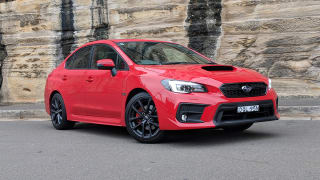
Subaru WRX Premium 2018 review
That the WRX is a wild-at-heart bang-for-bucks hero has never been in dispute. What's less certain, though, is whether it can also double as a toned-down family taxi.
Browse over 9,000 car reviews
This is the Hyundai i30 N like you've never seen it - because this is the new Fastback version.
It takes everything we knew about the i30 N and reshells it in a bigger, more sedan-like package. As the name suggests, it's more 'fast-back...y' than the regular hatch... And according to the brand, also a bit more premium and mature.
Hyundai calls it a five-door coupe, which is similar to what the luxury brands label their models with similar body styles. That's not a coincidence - the company told us the Merc CLA and Audi S3 were what it looked at when figuring where this model should be targeted.
And if you're wondering, the official name for this hatchback that isn't a hatchback? It's the i30 Fastback N, not the i30 N Fastback. Weird.
The name is one thing, but the look? Well... let's check it out.
| Hyundai I30 2019: Fastback N Performance | |
|---|---|
| Safety rating | |
| Engine Type | 2.0L turbo |
| Fuel Type | Premium Unleaded Petrol |
| Fuel Efficiency | 8.8L/100km |
| Seating | 5 seats |
| Price from | $34,210 |
I'm really keen to hear what you think about the design of this car - tell us in the comments if you're a fan, or if - like me - you're just not quite sold on the styling.
It is truly polarising. At the launch, you could almost split it down the middle of Australia's motoring scribes as to which were in the 'like it' vs the 'not so much' camps. Some of the older journos rated it. The younger ones weren't as convinced.
To my 34-year-old eye, the swoop of the roof is just a bit too hunched to make me go 'wow, that's like an Audi Sportback', but I can see plenty of Mercedes-Benz CLA and CLS influence in the rear end.
Hyundai reckons it's more mature looking and will likely appeal to that demographic of customer, too. The drive experience is aimed more at that buyer as well.
That said, it is considerably larger than the hatch model. Overall, the Fastback is 120mm longer (4455mm) and 28mm lower (1417mm) than the hatchback model, while the width (1795mm) and wheelbase (2650mm) go unchanged.
It's the wheelbase perhaps makes the design look a little less streamlined than it could be - if it were longer, the brand would have had more to play with in terms of the rake of the roofline.
Either way, though, it has a better drag coefficient than the hatch (0.297 Cd compared to 0.320 Cd), so it cuts through the air more cleanly.
That new roofline has had an impact on space for second row passengers - check out the interior pictures to see for yourself.
If a hatchback is a vehicle with five doors including one at the back that opens to a decently practical boot, then this is a hatchback. Just don't tell Hyundai I told you that, because the brand labels it a five-door coupe, or a Fastback. And one of the arguments for the existence of this car, apparently, is that isn't a hatchback. But, er, it is!
The boot is bigger in the Fastback - it offers 450 litres of cargo capacity, which is 55L more than the i30 hatch. Got kids? This is the next best thing to an i30 N wagon. Oh, how I wish there was an i30 N wagon... But I guess it'd actually be an i30 wagon N, based on the naming convention?
That boot space is a good size, even if it isn't the most practical - you can lower the back seats down, but there's a strut brace that sits behind the seats and seriously impinges load-through room.
The back seats of all so-called 'five-door coupes' are typically less comfortable than they could be, and the i30 Fastback N slots into that category, too.
The headroom is tight for anyone taller than six-foot, particularly for ingress and egress as the roofline is low but the seat is actually rather high. Legroom, knee room, shoulder space and toe room are decent for the size of the car, but not class leading. The seat is comfortable enough, but there are no rear air-vents.
The back has amenities such as mesh map pockets, bottle holders in the doors and a flip-down armrest with cup holders. Up front there's another pair of decaf-soy-latte grippers, big door pockets, some loose item storage and even a Qi wireless charging point if you get the Premium Pack.
The media screen is Hyundai's top-end 8.0-inch touchscreen unit, which has Apple CarPlay/Android Auto smartphone mirroring, built-in sat nav, USB and Bluetooth connectivity and the N computer system (which includes a lap timer, and also allows you to configure the car's settings, but you have to trigger the buttons on the wheel to get there).
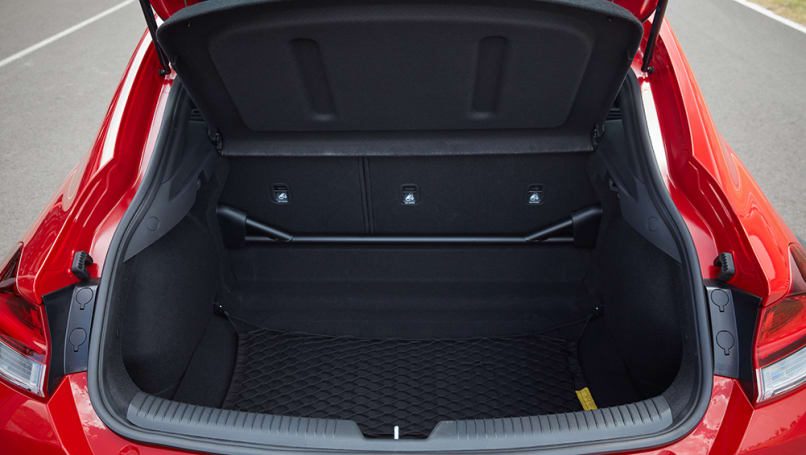
Buying the Hyundai i30 Fastback N will set you back $1500 more than the hatch version, with the list price set at $41,990 plus on-road costs. That equates to $27 per extra litre of cargo room, FYI.
Competitors? It's a broad mix. I think a Subaru WRX deserves to be on the shopping list if you're considering this model, and so does the regular i30 N hatch. It's hard not to include a VW Golf GTI, Golf R and even the Skoda Octavia RS in the mix, too.
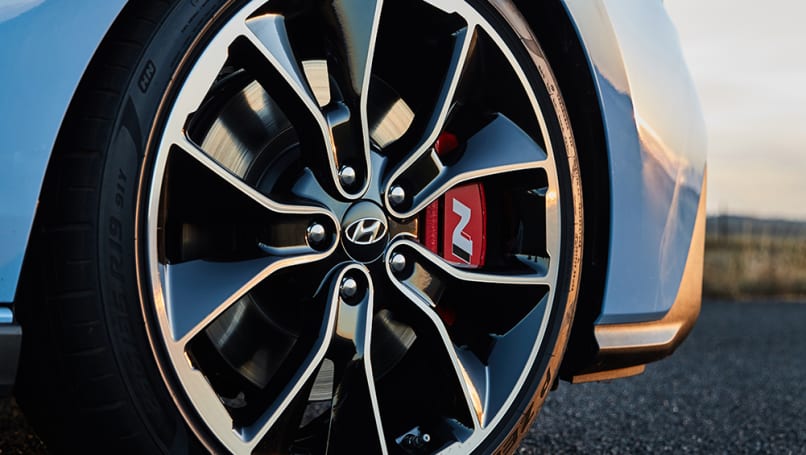
Standard equipment for the i30 Fastback N includes 19-inch alloy wheels with Pirelli P-Zero HN tyres, LED daytime running lights, auto LED headlights, LED tail-lights, tyre pressure monitoring, a reversing camera, and a temporary space saver spare wheel.
Inside there are alloy sports pedals, black headlining, red stitching (as opposed to blue in the hatch), sports front seats, a leather-appointed steering wheel, a 4.2-inch driver info screen, an 8.0-inch touchscreen with Apple CarPlay and Android Auto, Bluetooth phone and audio streaming, USB connectivity and built-in sat nav. Further, you get dual-zone climate control, cruise control, manual seats (driver's with power lumbar adjust)
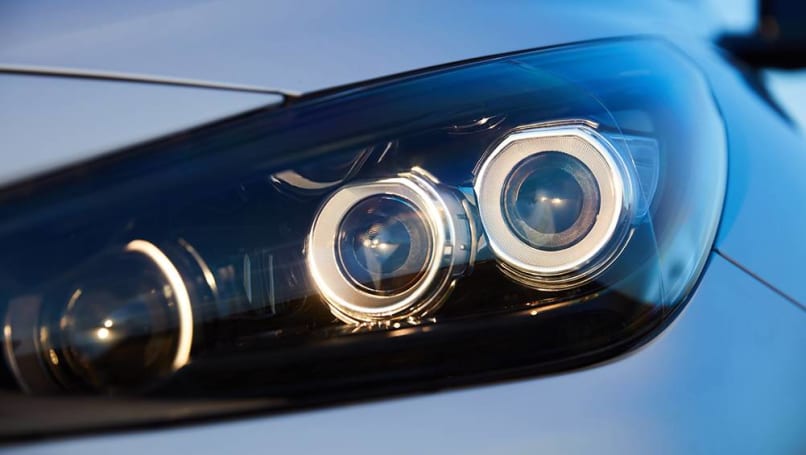
The $3000 luxury pack adds front parking sensors, LED courtesy and puddle lamps, power folding side mirrors, rain-sensing wipers, electric seat adjustment up front (driver's with memory settings), leather and suede trim, auto-dimming rear view mirror, heated front seats and steering wheel, smart key entry and push-button start, rear tinted glass and Qi wireless phone charging. Add $2000 and you get a panoramic sunroof, too.
See below for the safety specs.
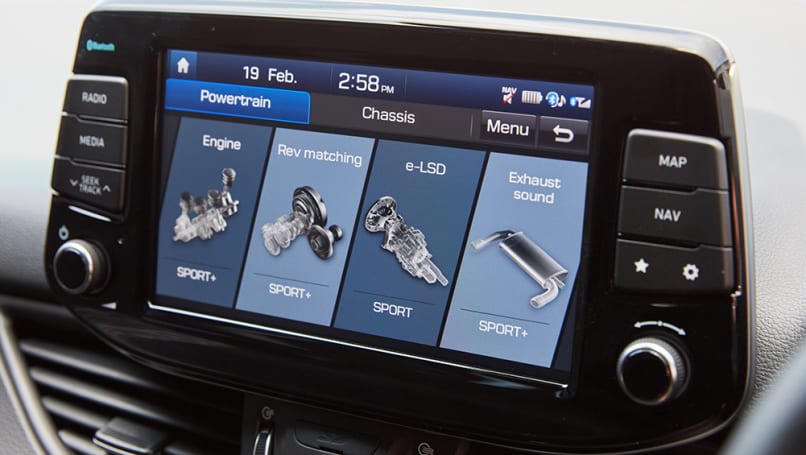
As with the other N model, the Fastback is powered by a 2.0-litre four-cylinder turbocharged engine producing 202kW of power (at 6000rpm) and 353Nm of torque (378Nm on overboost - from 1450-4700rpm).
At the time of writing it is only available with a six-speed manual transmission, and is front-wheel drive that features an electromechanical limited-slip diff.
There will be a dual-clutch automatic transmission added to the mix at some point - I'll talk more about that in the driving section below.

Official claimed fuel consumption is rated at 8.0 litres per 100 kilometres, using 95RON premium unleaded petrol as a minimum.
On our four-hour drive loop through South Australia - which included a few spirited mountain roads, some highway cruising and B-road bruising - we saw 9.1L/100km indicated on the dashboard. That's a good result, I reckon.
Fuel tank capacity is 50 litres.
Honestly, the changes described in the press material had me hoping for a pretty different drive experience to the i30 N hatch... but without a back-to-back drive, most people would be hard pressed to pick up on the differences. I'll admit it - I struggled, and Hyundai didn't give us the chance to sample the regular model against this one.
According to Hyundai, the Fastback N model rolls on a "new global chassis calibration" that was honed on the Nurburgring to reward the driver with "controlled and comfortable" handling - the very same tune that will be rolled out on the hatch sometime in 2019, according to the brand.
That tune incorporates a softer front suspension with reduced roll stiffness, which apparently makes it more comfortable but also more chuckable in corners. I thought the i30 N hatch was already pretty good at that, but oh well.
There are longer, softer bump-stops, as well as a new, narrower front anti-rollbar, plus the adaptive dampers are revised as well.
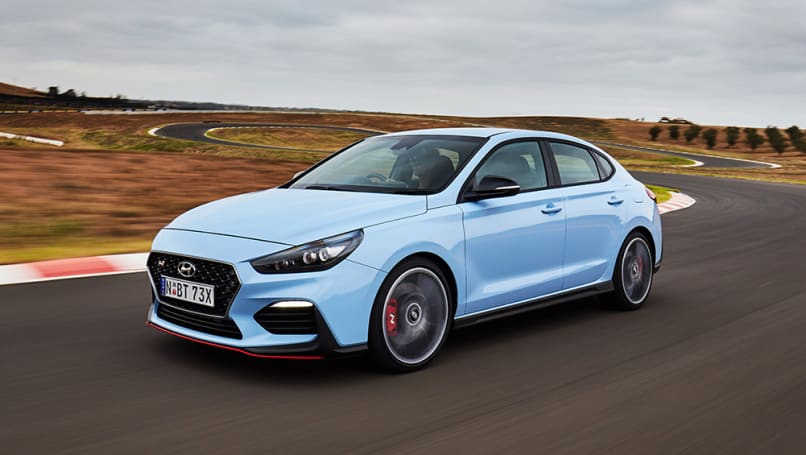
As for drive modes, you can choose from Eco, Normal and Sport drive modes, as well as N mode with an ESC Sport setting, and a configurable N Custom mode (my fave: Normal steering, Normal suspension, everything else in Sport+).
But I found that the Normal mode was still a bit too firm in a lot of situations, with the rear rebound after a bump making for a pretty bouncy ride over rough back roads, and sharp edges around town still upset progress to a reasonable degree. Put the suspension in its hardest mode and the ride is even more punishing, but that's to be expected. The steering weight is a bit too stiff, and though the rack is only two turns lock to lock, the turning circle is pretty large at 11.6m.
The i30 Fastback N is marginally heavier (12kg) mainly at the rear, which affects the weight distribution - the company says the ratio is 59.7 per cent front and 40.3 per cent rear, where the hatch is 61.8/38.2. That probably won't matter to the vast majority of owners and customers, but it theoretically helps with the more tail-happy character of the Fastback.
Unleashing the grunt of the engine and throwing the shifter between the gates, allowing it to do the throttle-blipping for you on downshifts - it takes a while for it to get old. But like most other front-wheel drive hot hatches, you can induce understeer if you approach a bend with too much heat, and there's also a bit of a battle to be had with the steering wheel under hard acceleration, with some torque-steer tug noticeable.

On the road you will still find yourself smiling stupidly when you lift off the throttle and hear the pop and fart of the exhaust system... provided you can hear it. If the surface is coarse - like a lot of highways and main roads in Australia - you might struggle, because there's a lot of road noise intrusion into the cabin. Some extra sound deadening wouldn't go astray.
Many of my criticisms are more around the perception of the new body type than the actual drive experience, which is still great for a high-powered hatch... fastback... coupe... whatever.
But with Hyundai's own marketing people telling us that this is a softer and more grown-up offering, I expected its character to match its more mature appearance a bit more than it did.
Basic Warranty
5 years / unlimited km warranty
ANCAP Safety Rating

The Hyundai i30 range is covered by a five-star ANCAP rating that was handed out in 2017 - but the i30 N was exempt from that rating, and the Fastback hasn't been scored.
That said, there are seven airbags (dual front, front side, full-length curtain and driver's knee) plus electronic stability control. Of course there's a reversing camera, plus there are rear parking sensors. Front sensors are available as part of the optional pack.
There is auto emergency braking (AEB) with forward collision warning, driver attention alert and lane keeping assist (above 60km/h), but the vehicle lacks pedestrian detection, cyclist detection, blind spot monitoring, rear cross-traffic alert, rear AEB and adaptive cruise control.
The i30 Fastback N gets dual ISOFIX child-seat anchor points and three top-tether hooks, too.
The standard factory warranty offered on all Hyundai models is five years/unlimited kilometres and that extends to the i30 N models, too. It covers "non-competitive racetrack driving, and the fitment of high-performance semi-slick tyres" - so unless you start modding your i30 N, you will retain your warranty.
Plus there's a lifetime capped-price servicing plan, with intervals set at 12 months/10,000km, whichever occurs first. The costs are very low for the first five years of ownership, with the first, second, third and fifth visits costing $299, and the fourth set at $399. So, a total over five years of $1595 (before consumable items are added) at an average of $319 per annum. Not bad.
And if you service your car at Hyundai, you will get up to 10 years' roadside assist included. It rolls over for every year you remain loyal.
There is no denying the Hyundai i30 Fastback N will appeal to a certain type of customer - probably someone who is a bit older and wants the steer clear of the 'boy racer hot-hatch' scene. This is a good car for someone who is young at heart, no doubt about it.
But I'm convinced the best version of an i30 Fastback N is still to come - one with a dual-clutch auto transmission, a bit more sound deadening and a 'comfort' mode for the suspension. Yeah. That'd help build the brand.
| Vehicle | Specs | Price* | |
|---|---|---|---|
| Active | 2.0L, ULP, 6 SP MAN | $16,280 – 20,900 | 2019 Hyundai i30 2019 Active Pricing and Specs |
| Active 1.6 Crdi | 1.6L, Diesel, 6 SP MAN | $18,040 – 22,880 | 2019 Hyundai i30 2019 Active 1.6 Crdi Pricing and Specs |
| GO Smartsense | 2.0L, ULP, 6 SP AUTO | $17,380 – 22,000 | 2019 Hyundai i30 2019 GO Smartsense Pricing and Specs |
| Active Smartsense | 2.0L, ULP, 6 SP AUTO | $19,250 – 24,420 | 2019 Hyundai i30 2019 Active Smartsense Pricing and Specs |
| Design | 7 |
|---|---|
| Practicality | 8 |
| Price and features | 8 |
| Under the bonnet | 9 |
| Efficiency | 8 |
| Driving | 8 |
| Safety | 7 |
| Ownership | 9 |
$15,990
Lowest price, based on 398 car listings in the last 6 months